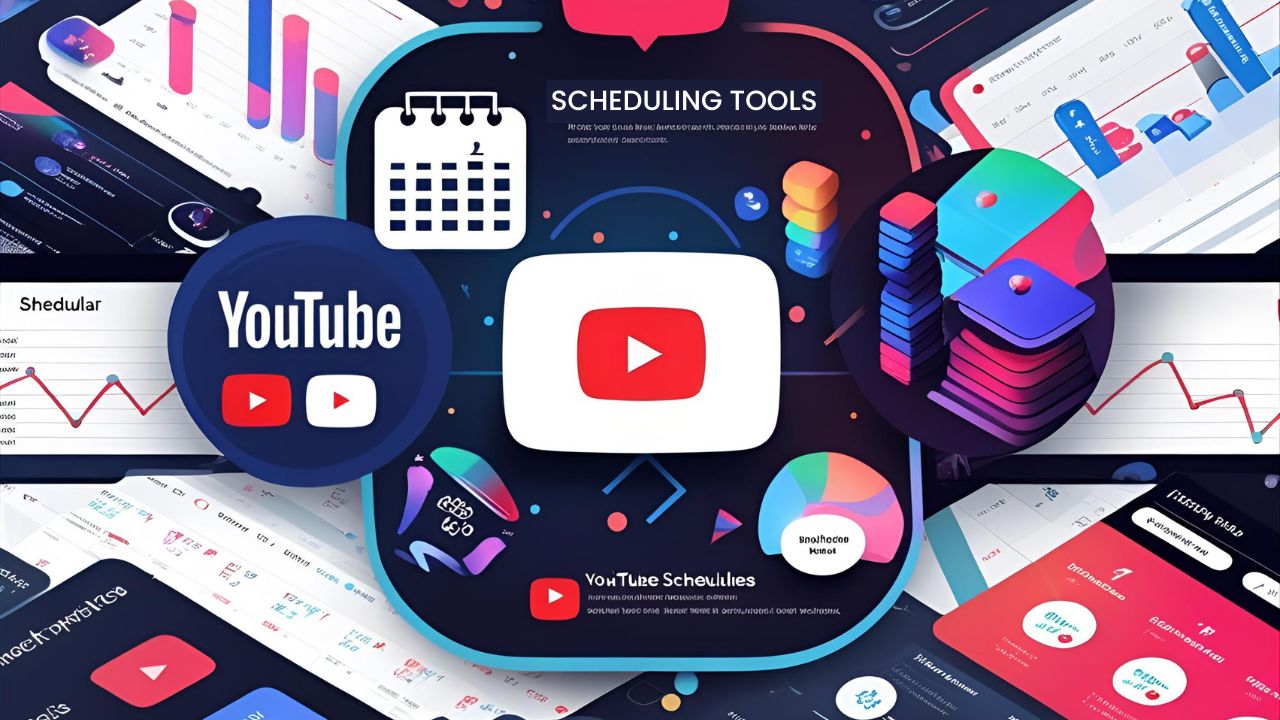Creation of content has reached new heights, and now the pros of YouTube realise that consistency is what makes or breaks a channel and gains or loses an audience. Nevertheless, it may be hard to schedule the uploading process manually to post videos at their best times, which can be a problem when handling more than one channel or producing content across time zones. It is here that Scheduling Tools would be extremely helpful as they allow content creators, agencies and businesses to streamline their video publishing process.
The Scheduling Tools field has been changing a lot in 2025, and it is providing creators with a level of control over their content distribution strategy, which has never been seen before. These programs not only make the otherwise tedious process of publishing automated, but also offer elaborate analytics, optimisation tools and the ability to cross-integrate with other platforms that have the potential to drive your channel considerably in terms of performance and growth curve.
The current YouTube Scheduling Tools are no longer limited to scheduling tools but now provide a complete content management platform that helps with thumbnail optimisation, audience engagement tracking and many more. You may be a single creator posting weekly vlogs, or a digital marketing agency with tens of client accounts, and the correct scheduling tool can allow you to skip the hours of manual inputs and have the biggest reach and impact of your content possible.
What Are YouTube Scheduling Tools?
- Automated Publishing Systems: These tools enable makers to release videos beforehand and assign particular dates and times of automatic release without manual management of the program during the most eager time.
- Cross-Platform Integration: Contemporary Scheduling Tools can be easily integrated with other social media so that a creator can keep the schedule of his/her content distribution synchronised with various media at the same time.
- Analytics and Performance Tracking: These are also the medium to give detailed information on video performance, the audience engagement levels and the best time to post depending on the history and analysis of the algorithm.
- Content Management Dashboards: Scheduling Tools provide a centralised interface where creators have access to all their content schedules in one area to organise, preview, and manage the whole content schedule.
- Optimisation Features: SEO tools, thumbnail testing capabilities, and metadata optimisation features that enhance video discoverability and engagement rates are also part of advanced scheduling platforms.
Why Use YouTube Scheduling Tools?
- Consistent Publishing Schedule: Regular upload schedules are a key ingredient to algorithm grace and the ability to keep an audience coming back, and scheduling applications will help make sure that your content keeps appearing, even when you can not.
- Global Audience Optimisation: Such instruments help creators to release content at the most appropriate time in different geographic locations, to reach the highest number of viewership across the international markets in a way that manual flights are not necessary.
- Improved Workflow Efficiency: Quality output over quantity. The way that people create content can be different too, by producing periods of content with multiple videos in run and allowing more time to focus on the production, corporations focus more on the quality of content than on publishing it one by one.
- Enhanced Analytics Insights: The metrics and trending analysis offered by Scheduling Tools go in-depth into the performance of a YouTube channel and enable creators to make evidence-based decisions concerning their content strategy, being either under- or over-posting.
- Professional Brand Management: Regularity and punctuality in posting content create the confidence of the audience in particular and hence the identity of the publication as being professional in its consideration, which is the primary criterion to actualise the monetisation and branding partnership possibilities.
Key Features to Look for in YouTube Scheduling Tools
- Bulk Upload Capabilities: It will also save a considerable amount of time for creators who batch or have multiple channels by being able to upload and schedule several videos at a time.
- Advanced Analytics Dashboard: In-depth reporting, which keeps track of performance, the demographics of your audience, and the engagement habits, can be of vital importance in perfecting your content-delivery strategy as time moves on.
- SEO and Metadata Optimisation: Findability and search ranking results. Incorporating search terms, suggestions of tags and optimisation of descriptions gives videos a better possibility of being found and acquired.
- Team Collaboration Features: The multi-user access, approval workflow and role-based accessibility are necessary in the shoulder of agencies and content creation teams working collaboratively on a larger scale.
- Cross-Platform Publishing: Other social media can also be integrated, and a coordinated social media marketing campaign can be organised, as well as wider distribution approaches of the material than YouTube alone.
Top 10 YouTube Scheduling Tools in 2025
1. TubeBuddy
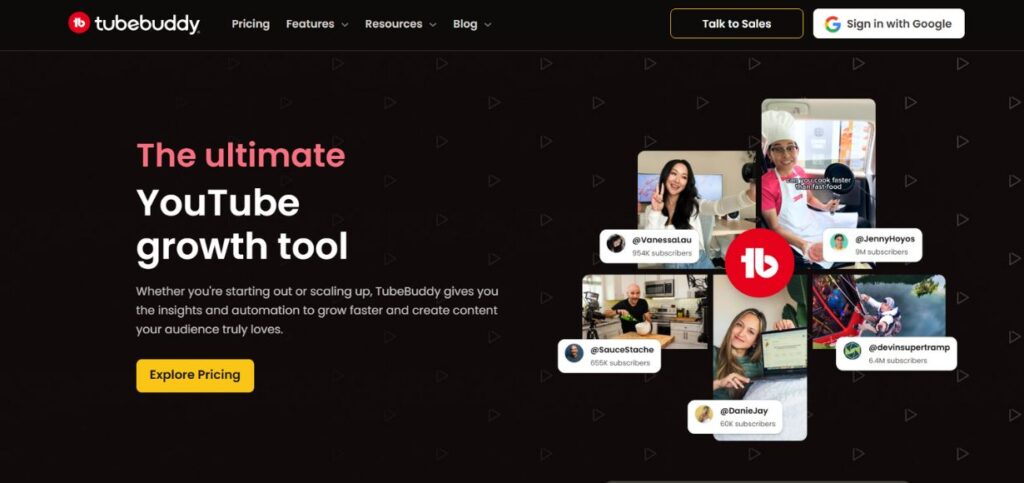
TubeBuddy would be the most broad-based YouTube-specific scheduling and optimisation service in 2025. Created with an exclusive focus on the needs of YouTube creators, this browser extension and web-based product has a whole arsenal of features such as superior video scheduling, A/B testing, and keyword research, along with powerful analytics dashboards. TubeBuddy has been built using YouTube Studio as its direct source, which allows direct integration into the workflow and optimisation recommendations in real-time. It has more than 10 million creators worldwide now, and it has set the industry standards on how YouTube channels can be managed and optimised.
Key Features:
- Advanced video scheduling
- A/B testing capabilities
- Comprehensive SEO tools
Pros:
- YouTube-specific optimization
- Extensive feature set
- Strong community support
Cons:
- Learning curve required
- Browser extension dependency
- Premium features expensive
Pricing: Plan starts at $2.41/mo
Best For: Individual creators and small teams focused primarily on YouTube growth.
Website: http://tubebuddy.com
2. Hootsuite

Hootsuite is also by far one of the most well-established social media management tools and can probably be labelled as one of the strongest in terms of offering scheduling attributes focused on YouTube, not to mention the full multi-platform strategy provided. By 2025, Hootsuite will have developed a better YouTube integration that enables better analytics, the ability to perform bulk scheduling, and coworker collaboration. It is also strong in the area of many social accounts in one place, as well as the driving of a harmonised cross-mounted campaign of various businesses and agencies. Hootsuite offers a 30-day free trial but has a professional plan at a starting price of $99/month, suggesting it as a solution oriented towards businesses with lots of options related to reporting and management of teams.
Key Features:
- Multi-platform scheduling
- Team collaboration tools
- Advanced reporting suite
Pros:
- Enterprise-grade features
- Comprehensive platform support
- Strong analytics capabilities
Cons:
- High pricing tiers
- Complex interface navigation
- Limited YouTube-specific features
Pricing: Plan starts at ₹1,915 per month per user/mo
Best For: Large businesses and agencies managing multiple social media accounts
Website: http://hootsuite.com
3. Buffer
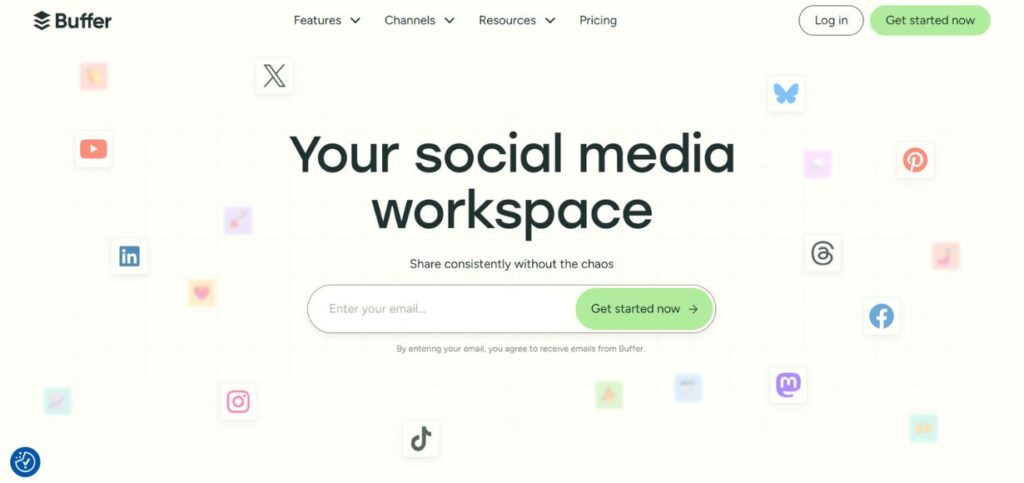
Buffer has become one of the most streamlined, user-friendly, and simple-to-use YouTube Scheduling Tools in 2025 without compromising on functionality. The platform has clean and streamlined interfaces for scheduling that allow content planning for creators regardless of their level of experience. The advantage of Buffer is that it has a simple and basic strategy on social media management, as well as strong analytical and optimisation tools. The ease of use and efficiency are what place Buffer as one of the best options, as professional plans begin at approximately 99/month. Medium has won a cult following amongst both personal creators and small organisations with its moderate monetisation and offering of features.
Key Features:
- Intuitive scheduling interface
- Cross-platform publishing
- Performance analytics
Pros:
- User-friendly design
- Affordable pricing tiers
- Clean analytics dashboard
Cons:
- Limited advanced features
- Basic YouTube optimisation
- No free plan
Pricing: Paid plan starts at $5/month; free plan available.
Best For: Small businesses and individual creators seeking simplicity.
Website: http://buffer.com
4. Loomly
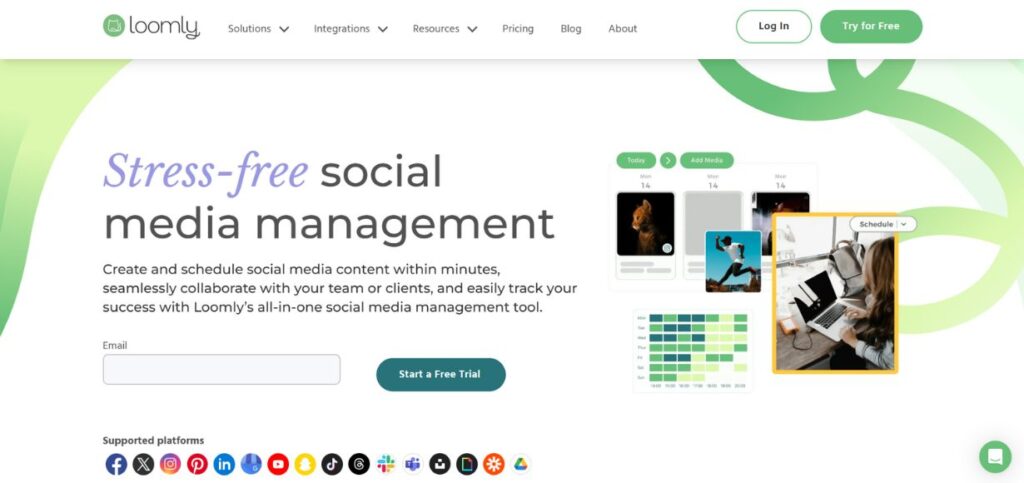
Loomly has positioned itself as an all-inclusive social media management system with a very focused capability of scheduling YouTube posts and collaborating with other members of a team. The service is focused on visual planning and organisation of work, which is why it will especially be attractive to creative teams and marketing departments. The content recommendations, approval process, and in-app editing Loomly provides allow simplifying the content generation process in one app as swiftly as possible, right up to publication. Loomly is very team-friendly, has amazing visual planning, and the base package is only 32 dollars a month when billed annually, so it fits the budget of a growing business and creative agency.
Key Features:
- Visual content calendar
- Team collaboration workflows
- Content suggestion engine
Pros:
- Strong collaboration features
- Visual planning interface
- Content ideation tools
Cons:
- Limited analytics depth
- Higher learning curve
- YouTube features basic
Pricing: Custom Pricing
Best For: Marketing teams and creative agencies requiring collaborative workflows
Website: http://loomly.com
5. SocialBee
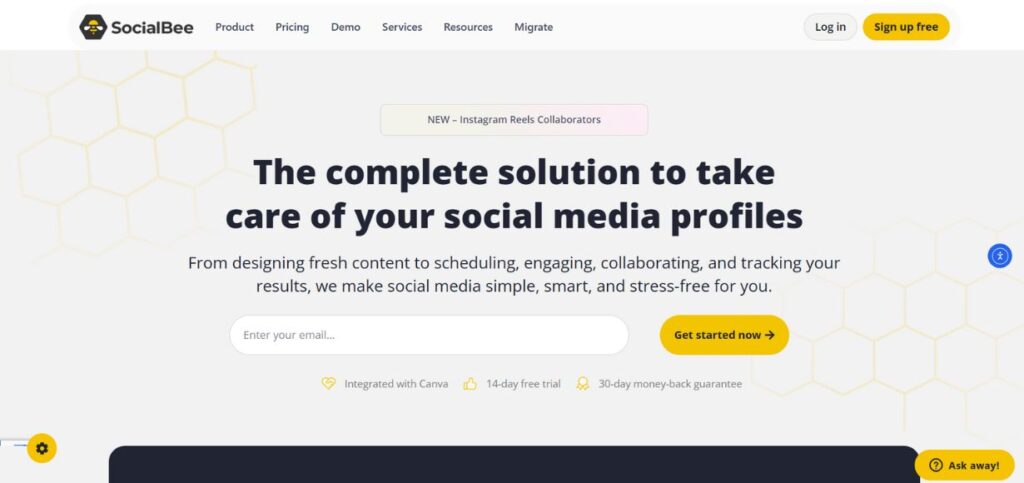
SocialBee stands out in the market of YouTube Scheduling Tools to mark a new category-based scheduling system and using AI to suggest content. The platform enables content creators to categorise their posts into distinct categories and rotate them automatically to ensure variance in the content postings. The advanced content recycling and management of evergreen content gives SocialBee a huge advantage in diverse aspects for the creators who desire to maximise the duration of their video content to exist. SocialBee has an AI suggestion category scheduling starting at the price of 29$ per month, and as such, it is more affordable than other tools and services that have more in-depth features.
Key Features:
- Category-based scheduling system
- AI content suggestions
- Evergreen content recycling
Pros:
- Innovative scheduling approach
- Content recycling features
- Competitive pricing
Cons:
- Limited YouTube optimisation
- Smaller user community
- Learning curve required
Pricing: Plans start at $24/month.
Best For: Content creators focused on long-term content strategy and recycling.
Website: http://socialbee.io
6. Sprout Social
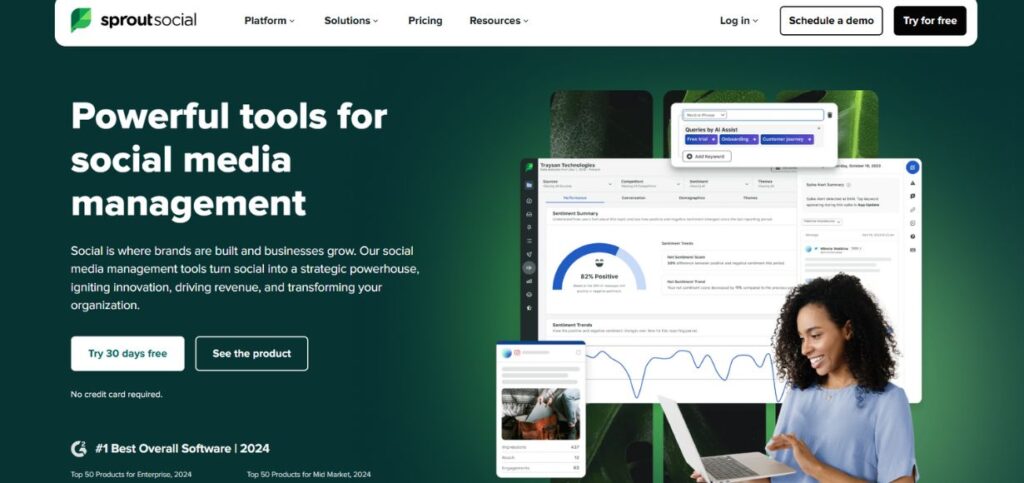
Sprout Social is the upper echelon of Scheduling Tools, which is enterprise-level, having advanced analytics, team management and reports. The platform is strong in terms of precision on audience insights, competitive intelligence and the wide breadth of social listening capabilities that go beyond the mere offering of a scheduling tool. Sprout Social has a minimum price of 259 per user per month, which indicates that it is an upper-end product that is used by companies that have large organisations and enterprises that need to creatively handle social media activities and report to their stakeholders in detail.
Key Features:
- Enterprise-level analytics
- Advanced team management
- Social listening tools
Pros:
- Comprehensive feature set
- Professional-grade analytics
- Excellent customer support
Cons:
- Very high pricing
- Complex setup process
- Overkill for individuals
Pricing: Plans start at $199 per user per month.
Best For: Large enterprises and corporations with extensive social media requirements
Website: http://sproutsocial.com
7. Metricool
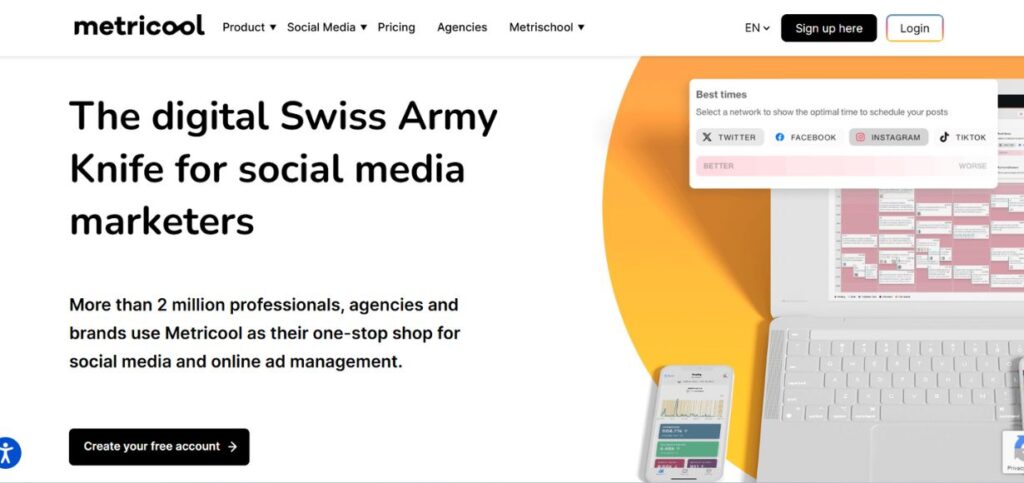
Metricool has been compared to some of the most powerful and popular YouTube Scheduling Tools and has come out to be one of the most cost-effective yet comprehensive Scheduling Tools available. The platform has powerful analytics, social monitoring, and scheduling options on different platforms such as YouTube. The advantage of Metricool is that it has professional features and capabilities, but at affordable prices, even smaller companies and individuals can now have a hold on excellent social media management. The affordable nature of Metricool means that their plans start as low as $18/month, which is unlikely to break the bank and puts it in the group of the most affordable all-in-one scheduling tools.
Key Features:
- Multi-platform analytics
- Cost-effective pricing
- Social media monitoring
Pros:
- Excellent value proposition
- Comprehensive free plan
- Strong analytics features
Cons:
- The interface could improve
- Limited YouTube optimisation
- Smaller feature ecosystem
Pricing: Free plan available; paid plans start at $18/month.
Best For: Budget-conscious creators and small businesses seeking comprehensive features.
Website: http://metricool.com
8. ContentStudio
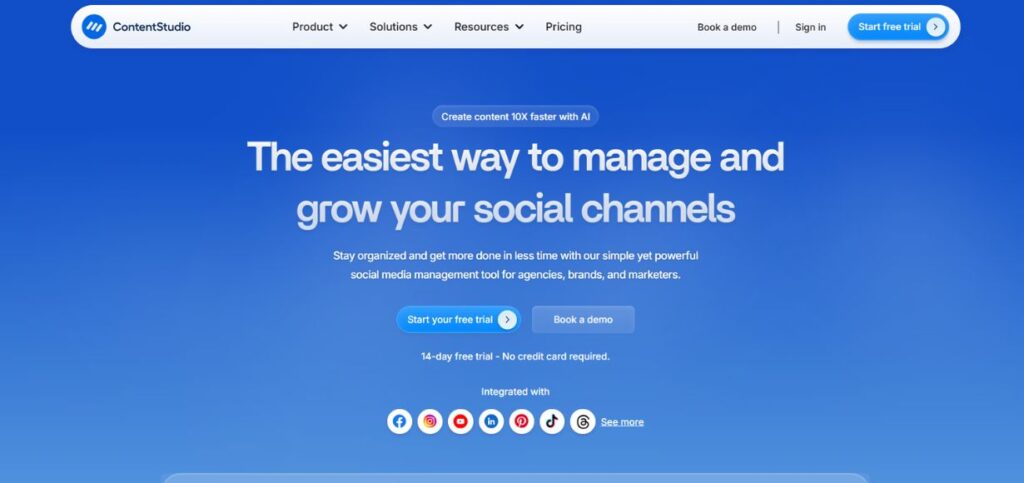
ContentStudio is an all-inclusive tool of content marketing that has a robust YouTube scheduler and an extensive content discovery tool. It is the best platform to curate content, schedule social media posts and collaborate with teams, and as a result, is of the highest value to content marketing teams and agencies. The content discovery engine of ContentStudio can assist creators in identifying trending topics and viral content opportunities, and its scheduling capabilities will make sure that there is a consistent publication on several platforms. Occupying one of the most competitive niches in the market, ContentStudio offers one of the most budget-friendly plans and is already working with thousands of creators, brands, and agencies.
Key Features:
- Content discovery engine
- Multi-platform scheduling
- Team collaboration tools
Pros:
- Affordable pricing structure
- Content curation features
- Comprehensive platform support
Cons:
- Interface complexity
- Limited YouTube optimisation
- Learning curve required
Pricing: Plans start at $19/month
Best For: Content marketing teams and agencies requiring content discovery and curation.
Website: http://contentstudio.io
9. Pallyy
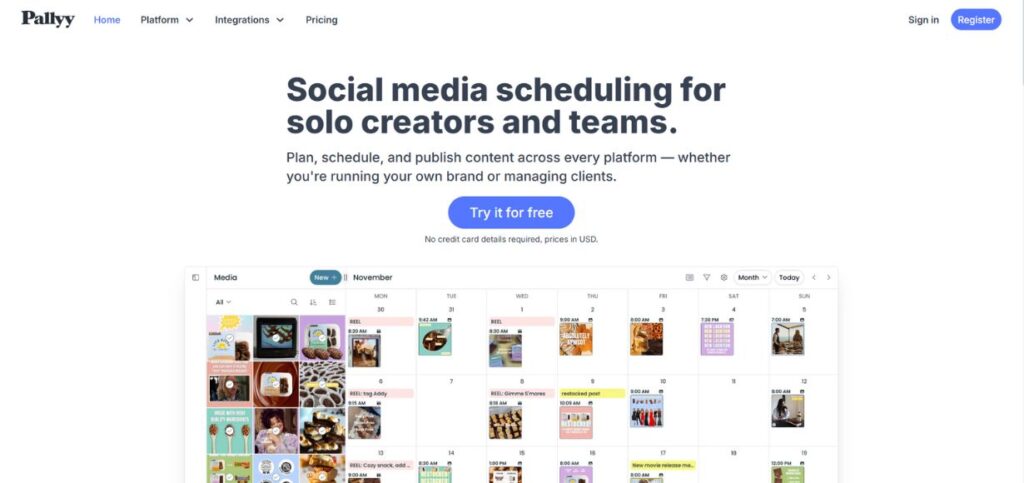
Pallyy has been rendered as a user-friendly, easy and straightforward YouTube scheduling Tool that is thoroughly optimised to be productive with individual creators and teams with fewer resources. The focus is on simple design, easy-to-comprehend workflows, and key scheduling functionalities instead of confusing users with a lot of complex functionality. The way in which Pallyy approaches this issue is appealing to those creators who are interested in powering features of a scheduling tool, but without high learning requirements and a complex interface. The platform accommodates various social media, and at the same time keeps the focus on convenience and stable functioning of content distribution on different platforms.
Key Features:
- Clean, intuitive interface
- Multi-platform support
- Solo creator focused
Pros:
- Simple setup process
- User-friendly design
- Reliable performance
Cons:
- Limited advanced features
- Smaller feature set
- Basic analytics capabilities
Pricing: Free, Paid Plan Starts at $25 /mo
Best For: Solo creators and small teams prioritising simplicity
Website: http://pallyy.com
10. vidIQ
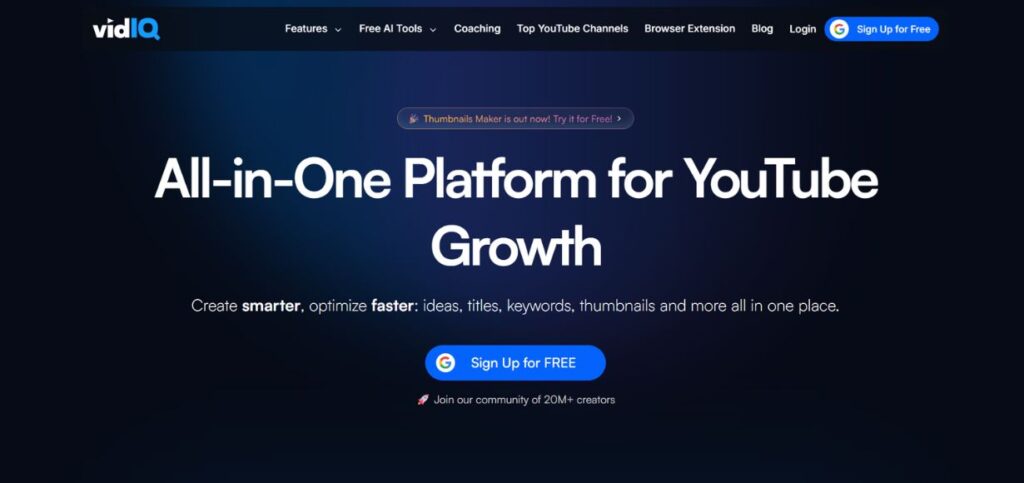
vidIQ is another YouTube-specific optimisation and scheduling service that blends potent analytics with big SEO potential and robust scheduling. The platform specialises specifically in YouTube growth and optimisation, and it features such tools as competitor analysis, keyword research, trend monitoring, and video performance forecasting. What makes vidIQ very powerful is its exclusive know-how on YouTube and the wealth of features available when growing a channel. VidIQ offers the ability to cope with the comments on YouTube by using the AI Comment Generator, which demonstrates its interest in managing YouTube as a whole and not just its most basic aspect, scheduling.
Key Features:
- YouTube-specific optimization
- Competitor analysis tools
- SEO and keyword research
Pros:
- YouTube-focused expertise
- Comprehensive optimisation tools
- Strong analytics capabilities
Cons:
- YouTube-only platform
- Limited cross-platform features
- Steep learning curve
Pricing: Custom Pricing.
Best For: YouTube creators focused exclusively on platform-specific growth and optimisation.
Website: http://vidiq.com
How to Choose the Right YouTube Scheduling Tool for You
- Assess Your Platform Requirements: Find out where you must have YouTube-only scheduling or multi-platform delivery functionality, since this is the underlying choice that will greatly limit the available options offered and incorporate the cost factor.
- Evaluate Team Collaboration Needs: Think also about whether you will be working alone or whether you need team management capabilities, approval processes, and multi-user access, because that distorts the parameters of what is required in terms of functionality dramatically, as well as the cost structure.
- Analyse Your Budget and Growth Trajectory: Consider current affordability and future scalability requirements, and make sure that your tool will allow your channel to scale in the future, so that you will not need to migrate platforms and will not lose the money you have already invested in them.
- Review Integration and Workflow Requirements: See how the scheduling tool can be incorporated into your current content creation process and how it will work along with other tools you may use to perform editing, analytics, or manage your audience.
- Consider YouTube-Specific vs. General Features: Choose between restrictive YouTube-related options (such as the use of SEO tools, thumbnail testing, and insights into the work of algorithms) or general social media management functionality.
Common Mistakes to Avoid When Scheduling YouTube Videos
- Ignoring Audience Time Zone Analysis: Publishing videos without taking into account both the geographic location of your main audience and their activity hours may decrease immediate and subsequent engagement and the promotion in the algorithm to a considerable extent.
- Over-Scheduling and Content Burnout: Posting at the wrong time can overload your viewers and reduce the effectiveness of individual videos in performance, and a lack of schedule will not only confuse viewers but also the YouTube algorithm.
- Neglecting Seasonal and Trending Content: When you do not make the necessary adjustments to your planned content calendar to accommodate the holidays or the trending versions or the seasonal frenzy, then a lack of visibility and engagement can be the obvious outcome.
- Inadequate Metadata Optimisation: Optimising the title, description and tags during rush time when it comes to placement can highly reduce the options of your video being quickly discovered and able to rank high in the universal search.
- Ignoring Analytics and Performance Data: As important as scheduling topics are, it is a waste of valuable information that YouTube Scheduling Tools give when scheduling content without any analysis of past video performance information and audience engagement trends.
Conclusion
Successful YouTube Scheduling Tool selection is merely the beginning of making use of YouTube and other platforms in such a way that your content is consistent and interesting, and that it really appeals to your target audience. Regardless of what your needs are and whether you are a one-person content creator in need of intuitive scheduling automation or a big agency dealing with the numerous channels of clients, the reviewed tools in this guide could become important steps on the way to having your content distribution operations running more efficiently and your channels performing better.
As long as YouTube keeps adapting and making competition among tracks to win the viewer more competitive, YouTube Scheduling Tools will get more and more necessary in enhancing competitive advantage in terms of distribution of content, engaging viewers and boosting channels. With the right scheduling platform, the advisable approach of implementing its use and consistent optimisation of your presence on YouTube can evolve from a time-consuming manual process to a streamlined, data-driven content machine that gains you an audience and frees up valuable time that you could spend on creative content creation.
Frequently Asked Questions
1. What is the best YouTube scheduling tool for beginners?
Both Buffer and Pallyy have the most intuitive interface to use that does not confuse the user with any over-the-top settings, and it is simple to schedule the posts. Other features that TubeBuddy offers include superb YouTube-specific instructions and tutorials where beginners are able to get instructed on the concept of optimisation and on how to schedule content smoothly.
2. Can I schedule YouTube Shorts with these tools?
The YouTube Scheduling Tool, used most of the time, would enable and support the YouTube Shorts scheduling, such as TubeBuddy, Hootsuite, and Buffer. Nonetheless, you need to ensure that the chosen platform can work with Shorts because not all tools can support the vertical video format or features that refer to Shorts.
3. Are free YouTube scheduling tools worth it?
Free versions of such tools as TubeBuddy, Metricool, and vidIQ may be useful to new creators or those with low funds. They are usually feature-limited but offer adequate scheduling functionality in case of their basic requirements, as well as enabling customers to test available platforms prior to engaging in paid plans.
4. How far in advance can I schedule videos?
The majority of YouTube Scheduling Tools will have the ability to plan months and sometimes even a full year ahead, and this number is different on each tool. The products which usually have the longest available scheduling periods are TubeBuddy and Hootsuite, whereas the more inexpensive tools might have less flexible scheduling periods.
5. Which one is the best to schedule either on YouTube Studio or third-party tools?
YouTube Scheduling Tools provided by a third party tend to perform better than YouTube Studio because they have better features such as analytics, search engine optimisation, en-mass planning, and multi-platform availability. Although the native scheduling process works well in YouTube Studio, the exclusive scheduling apps offer essential workflow flexibility and optimisation capabilities that optimise the content strategy immensely.
